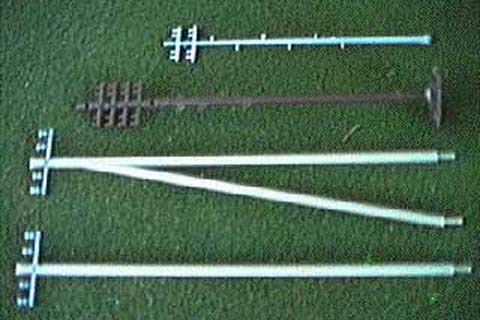Telegraph Poles
Faller 1:87 Scale Scenery Review

A comparision of telegraph poles from different manufacturers, top to bottom: Hasegawa (1:72), unknown manufacturer (H0), and two different poles from the Faller set (H0). Clearly, the Faller telegraph poles are much more realistic and compatible with 1:72 scale than the unusually short and thin poles available from Hasegawa. Nice surprise: The kit includes 20 telegraph poles, not 10 as indicated in the catalog and on the package itself. Presumably, the contents are correct and the packaging is in error, the price of $US 0.35 per pole seems about right.
Contents
20 Telegraph Poles with Wire
- Period II, after ca. 1921
- 40 Parts in 2 Colours
- 0.3 mm Nylon Thread (ca. 10 m)
- 1:72 Scale Height: 8.0 m
- 1:72 Scale Diameter: 22 cm
- Accessory: Transformer Station № 954
Evaluation
Important accessory: The telegraph poles are required to complete Faller kit № 954 of the rural transformer station. Telegraph poles are an important part of modern terrain, and they should be included on the table-top battlefield as well.
Scale model. The telegraph poles are 2.3 m taller and much thicker than comparable 1:72 scale poles made by Hasegawa and other manufacturers. The insulators measure 14 cm in diameter, a bit large, but easier to work with when the wiring needs to be added later.
Construction is a simple matter of glueing the insulator support into a slot at the top of the pole. The bottom end of the pole has a 6 mm lug which may be glued into a base board. Separate bases are not provided.
Good quality. The mould lines may be reduced by scraping it lightly with a scalpel.
The poles are cast in beige plastic, and they may be weathered to give them a more realistic appearance. In earlier periods, insulators supports would have been made of wood, and they should be painted accordingly.
The kits includes approximately 10 m of nylon thread, more than enough to wire the 20 poles. The thread comes wrapped around a piece of cardboard, and it has noticeable kinks in the line once it is uncoiled. A little tension on the line should eliminate the kinks. Otherwise, wrapping the thread around a thick cardboard tube and blow-drying it carefully may do the trick.
- Wiring the poles with nylon thread requires some patience and skill: The four strands of wire should
have about the same tension. Another method would be to drill tiny holes in the insulators and push 0.3 mm
pianowire through them.
The texture of the poles appears to be wood grain, but the poles are not tapered like trees.
Plastic bases are not included, the poles should be glued into a diorama base.
Historical Employment
- Rural Telegraph Line, after ca. 1921
Telegraph posts at the side of the road are typical of the modern battlefield, they appear in many photos of historic armoured vehicles. The strategic importance of wire communications makes telegraph lines a key target for raiding parties and Partizans. Security troops in rear areas are tasked to protect the line and repair any damage inflicted upon it. Simulation gamers typically use flexible terrain pieces which do not support permanently wired telegraph poles. An alternative would be to build short sections of a telegraph line, featuring three poles, and a stretch of road next to them. The poles on these mini-dioramas could be wired permanently.
Two adjacent terrain modules of this type could be wired temporarily by laying sections of pianowire across the insulator supports of the outermost poles. Pianowire looks like the nylon thread provided with this kit, and it does not sag when laid in sections. A temporary wire section between two terrain pieces would require four strands of pianowire, equally spaced. If a horizonal spacer is glued or soldered across either end of the pianowire strands, the resulting telegraph wire bridge can be placed on the poles in one piece. If a terrain module is picked up or shifted, these placed wire sections fall off without damaging the line, and they are easily replaced. There are enough telegraph poles in this set to create six terrain modules with three poles each. The two remaining poles may be combined with the transformer station to create another module. The combined length of the line is 2-3 metres, including the removable wire bridges, based on a spacing of 10–15 cm between poles.